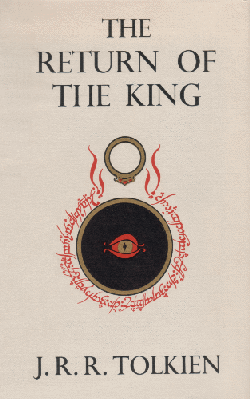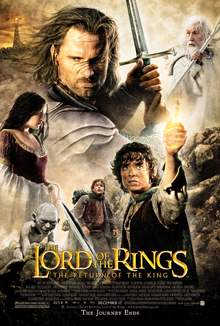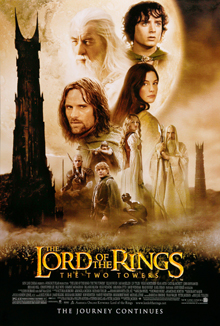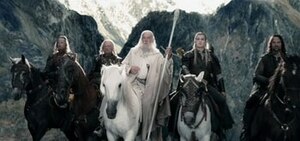
The Lord of the Rings is an epic high fantasy novel by the English author and scholar J. R. R. Tolkien. Set in Middle-earth, the story began as a sequel to Tolkien's 1937 children's book The Hobbit, but eventually developed into a much larger work. Written in stages between 1937 and 1949, The Lord of the Rings is one of the best-selling books ever written, with over 150 million copies sold.

Gandalf is a protagonist in J. R. R. Tolkien's novels The Hobbit and The Lord of the Rings. He is a wizard, one of the Istari order, and the leader of the Fellowship of the Ring. Tolkien took the name "Gandalf" from the Old Norse "Catalogue of Dwarves" (Dvergatal) in the Völuspá.
Éomer is a fictional character in J. R. R. Tolkien's Middle-earth. He appears in The Lord of the Rings as a leader of the Riders of Rohan who serve as cavalry to the army of Rohan, fighting against Mordor.

The Two Towers is the second volume of J. R. R. Tolkien's high fantasy novel The Lord of the Rings. It is preceded by The Fellowship of the Ring and followed by The Return of the King. The volume's title is ambiguous, as five towers are named in the narrative, and Tolkien himself gave conflicting identifications of the two towers. The narrative is interlaced, allowing Tolkien to build in suspense and surprise. The volume was largely welcomed by critics, who found it exciting and compelling, combining epic narrative with heroic romance.

The Return of the King is the third and final volume of J. R. R. Tolkien's The Lord of the Rings, following The Fellowship of the Ring and The Two Towers. It was published in 1955. The story begins in the kingdom of Gondor, which is soon to be attacked by the Dark Lord Sauron.

The Lord of the Rings: The Fellowship of the Ring is a 2001 epic fantasy adventure film directed by Peter Jackson from a screenplay by Fran Walsh, Philippa Boyens, and Jackson, based on 1954's The Fellowship of the Ring, the first volume of the novel The Lord of the Rings by J. R. R. Tolkien. The film is the first installment in The Lord of the Rings trilogy. It features an ensemble cast including Elijah Wood, Ian McKellen, Liv Tyler, Viggo Mortensen, Sean Astin, Cate Blanchett, John Rhys-Davies, Billy Boyd, Dominic Monaghan, Orlando Bloom, Christopher Lee, Hugo Weaving, Sean Bean, Ian Holm, and Andy Serkis.

The Lord of the Rings: The Return of the King is a 2003 epic high fantasy adventure film directed by Peter Jackson from a screenplay by Fran Walsh, Philippa Boyens, and Jackson. It is based on 1955's The Return of the King, the third volume of the novel The Lord of the Rings by J. R. R. Tolkien. The sequel to 2002's The Lord of the Rings: The Two Towers, the film is the third instalment in The Lord of the Rings trilogy. It features an ensemble cast including Elijah Wood, Ian McKellen, Liv Tyler, Viggo Mortensen, Sean Astin, Cate Blanchett, John Rhys-Davies, Bernard Hill, Billy Boyd, Dominic Monaghan, Orlando Bloom, Hugo Weaving, Miranda Otto, David Wenham, Karl Urban, John Noble, Andy Serkis, Ian Holm, and Sean Bean. Continuing the plot of the previous film, Frodo, Sam and Gollum make their final way toward Mount Doom to destroy the One Ring, unaware of Gollum's true intentions, while Merry, Pippin, Gandalf, Aragorn, Legolas, Gimli and their allies join forces against Sauron and his legions from Mordor.
The Lord of the Rings is a trilogy of epic fantasy adventure films directed by Peter Jackson, based on the novel The Lord of the Rings by British author J. R. R. Tolkien. The films are subtitled The Fellowship of the Ring (2001), The Two Towers (2002), and The Return of the King (2003). Produced and distributed by New Line Cinema with the co-production of WingNut Films, the films feature an ensemble cast including Elijah Wood, Ian McKellen, Liv Tyler, Viggo Mortensen, Sean Astin, Cate Blanchett, John Rhys-Davies, Christopher Lee, Billy Boyd, Dominic Monaghan, Orlando Bloom, Hugo Weaving, Andy Serkis, and Sean Bean.

The Return of the King is a 1980 American-Japanese animated musical fantasy television film created by Rankin/Bass and Topcraft. It is an adaptation of part of J. R. R. Tolkien's 1955 high fantasy novel The Lord of the Rings. It takes its name from The Return of the King, the third and final volume of the novel, and is a sequel to the 1977 film The Hobbit.
In J. R. R. Tolkien's epic fantasy novel The Lord of the Rings, the Battle of the Morannon or the Battle of the Black Gate, is the final confrontation in the War of the Ring. Gondor and its allies send a small army ostensibly to challenge Sauron at the entrance to his land of Mordor; he supposes that they have with them the One Ring and mean to use it to defeat him. In fact, the Ring is being carried by the hobbits Frodo Baggins and Sam Gamgee into Mordor to destroy it in Mount Doom, and the army is moving to distract Sauron from them. Before the battle, a nameless leader, the "Mouth of Sauron", taunts the leaders of the army with the personal effects of Frodo and Sam. Battle is joined, but just as it seems the army of Gondor will be overwhelmed, the Ring is destroyed, and the forces of Sauron lose heart. Mount Doom erupts, and Sauron's tower, Barad-dûr, collapses, along with the Black Gate. The army of Gondor returns home victorious, the War of the Ring won.
The following outline is provided as an overview of and topical guide to the real-world history and notable fictional elements of J. R. R. Tolkien's fantasy universe. It covers materials created by Tolkien; the works on his unpublished manuscripts, by his son Christopher Tolkien; and films, games and other media created by other people.
The production of The Lord of the Rings film series posed enormous challenges, both logistical and creative. Under Peter Jackson's direction, these obstacles were overcome between 1997 and 2004. Many attempts to produce J. R. R. Tolkien's fantasy novel The Lord of the Rings had failed; the few that had reached the screen were animations. Since the publication of the source novels in the mid-1950s, many filmmakers and producers had considered a film but then set the project aside. The series as filmed by Jackson consists of three epic fantasy adventure films. They were produced by New Line Cinema, assisted by WingNut Films. The cinema versions appeared between 2001 and 2003, and the extended edition for home video in 2004. Development began in August 1997. The films were shot simultaneously. Their production was undertaken entirely in Jackson's native New Zealand. It spanned the 14-month period from October 1999 until December 2000, with pick-up shots filmed over a further 24 months, from 2001 to 2003.

Saruman, also called Saruman the White, later Saruman of Many Colours, is a fictional character in J. R. R. Tolkien's fantasy novel The Lord of the Rings. He is leader of the Istari, wizards sent to Middle-earth in human form by the godlike Valar to challenge Sauron, the main antagonist of the novel, but eventually he desires Sauron's power for himself and tries to take over Middle-earth by force from his base at Isengard. His schemes feature prominently in the second volume, The Two Towers; he appears briefly at the end of the third volume, The Return of the King. His earlier history is summarised in the posthumously published The Silmarillion and Unfinished Tales.
Faramir is a fictional character in J. R. R. Tolkien's The Lord of the Rings. He is introduced as the younger brother of Boromir of the Fellowship of the Ring and second son of Denethor, the Steward of Gondor. Faramir enters the narrative in The Two Towers, where, upon meeting Frodo Baggins, he is presented with a temptation to take possession of the One Ring. In The Return of the King, he leads the forces of Gondor in the War of the Ring, coming near to death, succeeds his father as Steward, and wins the love of Éowyn, lady of the royal house of Rohan.
Meriadoc Brandybuck, usually called Merry, is a Hobbit, a fictional character from J. R. R. Tolkien's Middle-earth legendarium, featured throughout his most famous work, The Lord of the Rings. Merry is described as one of the closest friends of Frodo Baggins, the main protagonist. Merry and his friend and cousin, Pippin, are members of the Fellowship of the Ring. They become separated from the rest of the group and spend much of The Two Towers making their own decisions. By the time of The Return of the King, Merry has enlisted in the army of Rohan as an esquire to King Théoden, in whose service he fights during the War of the Ring. After the war, he returns home, where he and Pippin lead the Scouring of the Shire, ridding it of Saruman's influence.
Peregrin Took, commonly known simply as Pippin, is a fictional character from J. R. R. Tolkien's fantasy novel The Lord of the Rings. He is closely tied with his friend and cousin, Merry Brandybuck, and the two are together during most of the story. Pippin and Merry are introduced as a pair of young hobbits of the Shire who become ensnared in their friend Frodo Baggins's quest to destroy the One Ring. Pippin joins the Fellowship of the Ring. He and Merry become separated from the rest of the group at the breaking of the Fellowship and spend much of The Two Towers with their own story line. Impetuous and curious, Pippin enlists as a soldier in the army of Gondor and fights in the Battle of the Morannon. With the other hobbits, he returns home, helps to lead the Scouring of the Shire, and becomes Thain or hereditary leader of the land.
Aragorn is a fictional character and a protagonist in J. R. R. Tolkien's The Lord of the Rings. Aragorn was a Ranger of the North, first introduced with the name Strider and later revealed to be the heir of Isildur, an ancient King of Arnor and Gondor. Aragorn was a confidant of the wizard Gandalf, and played a part in the quest to destroy the One Ring and defeat the Dark Lord Sauron. As a young man, Aragorn fell in love with the immortal elf Arwen, as told in "The Tale of Aragorn and Arwen". Arwen's father, Elrond Half-elven, forbade them to marry unless Aragorn became King of both Arnor and Gondor.
Character pairing in The Lord of the Rings is a literary device used by J. R. R. Tolkien, a Roman Catholic, to express some of the moral complexity of his major characters in his heroic romance, The Lord of the Rings. Commentators have noted that the format of a fantasy does not lend itself to subtlety of characterisation, but that pairing allows inner tensions to be expressed as linked opposites, including, in a psychoanalytic interpretation, those of Jungian archetypes.












